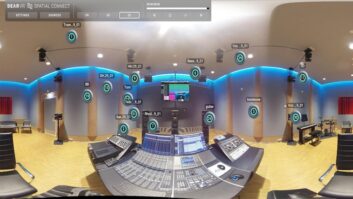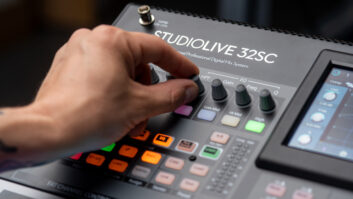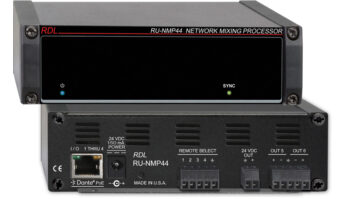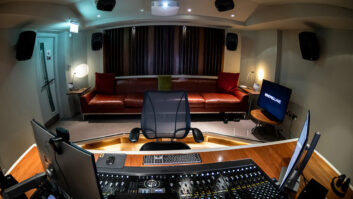It’s a given that nearly every aspect of the world of audio production is constantly in flux, shaped by the latest formats and equipment in vogue at any particular moment. If you revisit our articles on “current issues in mixing” from seven or eight years ago, you would read a lot about format compatibility. At the time, many mixers were dealing with projects that combined 2-inch multitrack (analog or digital, and in many cases both), either ADAT or DA-88 MDM tapes and perhaps some sort of hard disk source, as well; had to love the editing capabilities of those systems, even if they didn’t always sound so good. The outboard gear that was used to “warm up” the digital tapes was different from what might be needed for tracks recorded to analog tape, precisely because that medium was already warm. And the MDM tracks often sounded thin next to the 2-inch ones.
Jimmy Douglass: “One thing that’s really bad is getting all these [hard disk] files that are not labeled in any way.”
But that way of working is so last century. When I reach hot New York — based R&B mixer Jimmy Douglass (Aaliyah, Missy Elliot, Jay Z, The Game, Jamie Foxx) on his cell phone as he’s cruising around Manhattan, I mention the format compatibility issue and he just laughs. “Not even an issue. Get over it, man!” and he laughs again. “Earlier on, a few years ago, it was a nightmare; it was like the Wild West because everybody had different formats, nobody thought about what was going to happen later [in the mix] and everyone was doing all kinds of wild shit. Now, the conformity level has gotten to the point where, for instance, you can take something from Logic and put it into Pro Tools because they know how to save it as .WAV files so you can import it easily — all that kind of stuff. Most of the compatibility issues have disappeared.”
Okay, so what is a mixing issue for you these days? Douglass doesn’t hesitate: “One thing that’s really bad and also really common is getting all these [hard disk] files that are not labeled in any way. I had the biggest nightmare awhile ago with this guy who was doing his album over the course of about a year-and-a-half and I didn’t realize he was doing it at home. When I told him, ‘Give me all the .WAV files,’ he did, but he didn’t label anything, and he must’ve had around 60 tracks of stuff. I don’t know if he didn’t have an assistant or just hadn’t bothered, but it was bad. These songs were like eight minutes long each and they were all in real time, so it’s not like I could find a chorus and say, ‘Oh, that’s going to happen every time.’ Instead, every time it would come around, something different would happen, so I had to actually listen to every single one, and I didn’t know what was on every track because they weren’t labeled. It’s not like putting a tape up in a studio and knowing roughly how things are going to be organized, track-wise.
“On the first song I worked on,” he continues, “I had to go through all these unlabeled background parts, too — and he didn’t double or triple the backgrounds; he had different parts. So he’d have about 15 parts and I didn’t know what any of them were, and I had to listen to every single one to get a blend and so forth. So I called him back, and said, ‘Listen, on all the rest of these songs, send me a 2-track blend. Same thing with the horns.’ He must’ve had about 30 tracks — bones, trumpets, the whole gamut — and they weren’t doubling their parts; they were all playing different parts, different notes every time. As .WAVs, they weren’t blended at all; it was all just raw data, so to blend them was a nightmare. I said, ‘I can’t actually do the stuff unless you blend them and send me your 2-track blend.’ So once that was together and everything got sorted out, then it became a regular mixing project.” What’s the moral of the story, Jimmy? “Help your mixer out, man!” and he laughs again.
A few days later, I mention that anecdote to L.A. producer/engineer Joe Chiccarelli (Frank Zappa, Elton John, Beck, U2, All American Rejects, Pink Martini) as he drives from the San Francisco airport to a session at Soundworks studio downtown. “Oh,” he says gravely. “Unlabeled. That happens to me every other week. That’s the new world order. The days of a well-labeled track sheet are long gone. Now, you take two or three hours out of a mix just to find out what’s in there.
“One of my other pet peeves,” he adds, “is that people treat digital like it’s this incredible, indestructible medium because ‘digital files don’t change!’ People fly files all around the world and convert them to MP3 and then convert them back. They copy things from drive to drive to drive assuming there’s no degradation whatsoever, but there is. I can’t even generalize about the kinds of things that can turn up, whether it’s drop-outs or clock issues. But little things are happening. So I always make a point to go back to the original drive and work off the original file if possible. It can’t hurt.”
But the main issue Chiccarelli wants to discuss is a different aspect of the home studio revolution and how it affects his job as a mixer: “I think the art of recording vocals is at an all-time low,” he says. “It’s wonderful that everybody gets to do it at home and gets to take their time and make sure the performance is great. Unfortunately, what you get from being in a great-sounding studio with really good gear and being able to fine-tune your compression settings, et cetera, is often lacking in these projects. People recording at home often don’t have access to good microphones or good preamps, or they’re inexperienced with using a compressor, so they either use it improperly or maybe they’re frightened and won’t use it at all. Or they record the vocals in a bedroom that has some sonic issues. When you’re in an environment where you have all the proper tools and you can trust the monitoring, you definitely make better decisions. Often, when I get tracks to mix that were recorded in someone’s home, I end up spending a lot of time repairing things that weren’t done right or making up for inaccuracies in the home monitoring environment. People get fooled when they buy these cheap studio monitors that are on the hype-y side. They can’t hear that what they’ve done is thin.”
So what can you do about that, Joe? “One thing I do a lot is put the vocal on multiple channels of the console, whether it’s on a regular console or in the box [DAW]. I’ll mult the vocals to a number of channels and I might compress it differently for the chorus of the song than I would for the verse. I might add a short kind of modulated delay to give a double-track effect in the choruses to help the vocal in the chorus, and maybe I’ll put a long delay in the bridge. It depends on the music, of course, but sometimes I’ll add distortion to the vocal. I’ll find the vocal is a little bland and lacks personality, so I might overload a mic preamp to add a little excitement. A lot of times, I’ll use the Thermionic Culture Vulture, which is the most beautiful-sounding distortion box I’ve ever heard. I use it on vocals a lot to make a vocal cut through a mix; poke through the track.”
And how about those tracks that come in already overloaded with distortion? “The odd fix for a vocal that’s over-compressed,” he offers, “is if you compress it some more with the proper kind of distortion, you can get back some of the dynamics. I know that sounds bizarre, but if you fiddle with the attack and release, you can make it have a bit more shape. Almost any issue can be addressed, but the more repair work you have to do on a mix, the less time you maybe have to be creative.”
Jack Joseph Puig: “I realized that this subsonic energy was freaking out the compressors.”
Over in the depths of L.A.’s Ocean Way Recording, under the soft glow of colored lights, producer/engineer/mixer extraordinaire Jack Joseph Puig (Black Crowes, Hole, No Doubt, Verve Pipe, Goo Goo Dolls, John Mayer) sits in his exotic tricked-out studio room, racking his brain to think of some mixing issue he’s had to deal with. Confident, maybe even a little brash, Puig rarely runs into problems — he’s a master of his recording and mixing environment. But he calls back a couple of days later and relates this tale, which goes to the heart of the modern “problem” of the seemingly unlimited bandwidth of digital media.
“I mixed a record where they had processed a lot of the guitars with synthesizer modules,” he says. “The record had originally been sent to a prestigious mixer and he spent four days trying to mix some of the songs, but after that time, he wasn’t happy with how it sounded; nobody was happy. No matter what they did, they couldn’t get the record to feel right. A&R flew down to work on it with the mixer and they had the same problem: ‘We don’t know what it is, but something’s not right. No matter what we do, the core is always collapsing.’ The sounds got weird and the meters would do strange things, like they’d stick as if they were broken.
“So at that point, the mixer and A&R person quit trying to make it work and the parties involved decided to solicit my services. So I put it up in my room and I started working on it, and I was like, ‘Damn, this thing is weird! Something’s not right here.’ So I flipped it from the [Yamaha] NS-10s to the Tannoys, and the Tannoys started fibrillating as if the whole track had tremolo on it. On any other speaker you couldn’t hear it. So I realized, ‘Oh my gosh, there’s some subsonic shit somewhere on this, and what these people are experiencing with their systems that might not be as great as the resolute system that I’m on is their systems are collapsing, but mine’s trying to play it.’ Mine can play 1 Hz, where some systems can’t go down that low. The producer’s a low-end freak and likes to use synthesizers — manipulating square waves and sine waves — for extra low end, but you end up with a lot of subsonic energy, and if you have that over a multiple number of tracks and you’re not careful, what ends up happening is you get this buildup and it starts to sound really weird.
“The band told me they blew up something like 25 pairs of NS-10s during the project, and I’m thinking, ‘Guys, the NS-10s are trying to tell you something!’ So I realized that this subsonic energy was freaking out all the compressors, and I became very creative in my choice of filtering to not destroy the sonic quality of what they had recorded but to correct the sonic energy that was freaking out the compressors. So I was filtering at 20 Hz, 5 Hz, 10 Hz, 1 Hz on different channels, trying to get to where the issues were. So I did that and — boom — the whole thing began to clean up. It took awhile, but I figured it out and basically fixed it.”
Rafa Sardina: “One technical advance that made it possible was the use of the Internet to send and receive files.”
Grammy-winning engineer/producer Rafa Sardina, Spanish by birth but a longtime L.A. transplant, has a sturdy track record with many Latin and Anglo projects (Macy Gray, Luis Miguel, Angie Stone, Alejandro Sanz), as well as, from time to time, music-for-film projects. Working with files from different film composers, “You get all sorts of formats, especially Logic Audio; there seems to be a migration to that in this community of composers,” he says. “A lot still use Digital Performer, and a couple of times I’ve had people sending me stuff from Cubase. It can be time-consuming importing into Pro Tools, but it isn’t hard.”
Sardina says that on a recent film score for Madea’s Family Reunion, “We had to work on a few different locations simultaneously and the one technical advance that made it possible was the use of the Internet to send and receive files among all the people involved in the project. Regardless of the advances, the one thing that really shocks me is the fact of being at my own studio, After Hours in Los Angeles, mixing all of the music and not seeing anyone else involved during the process: Every decision, comment or change was transmitted over the Internet. I recorded the score in New Orleans, and two days later, I was already mixing at my studio. The orchestral work was self-explanatory, but the other half of the cues in the movie were so diverse that I had to use my gut and sense of the atmosphere the scenes were going for. There were full-band pieces, percussion cues and anything else imaginable. I nailed most of them, and the ones I didn’t, I got an e-mail with the revision notes! I was missing that human interaction.”
Paul Klingberg: “I created 10 or 12 Websites where I could take whatever the final video was and marry it with the stereo mix.”
Paul Klingberg, another L.A. engineer and mixer (Earth, Wind & Fire; Jonathan Butler; Don Grusin; Loreena McKennitt) was faced with a similar issue when it came time for him to mix the Farm Aid 20th Anniversary concert for the In-Demand network last Thanksgiving. “It was a huge project,” he says. “It was an all-day event, and I think there were 15 artists, including Willie Nelson, who was kind of the mayor of that whole thing; there were also Dave Matthews, John Mellencamp, Neil Young, Kenny Chesney, John Mayer, Los Lonely Boys and some lesser-known artists. Each did a set, and we ended up with 12 hours of recorded material. We had two trucks doing the recording: Biff Dawes from Westwood One and Timothy Powell from Metro Mobile in Chicago.
“It’s one thing to mix a concert and deal with one artist: You talk to them, maybe swap CDs. But this was 15 artists, and all the major artists wanted to hear the mixes. There weren’t any fixes because there was live video, too, of course, but there were some edits and they wanted to hear those. So what I ended up doing is something I’ve been doing for a while. I created 10 or 12 individual Websites where I could take whatever the final video was and marry it with the stereo mix. Then the artists or whoever could go onto the Website, hear what I was doing and give me immediate feedback. I’d make some fixes and immediately update the Website with the changes. That wouldn’t work for the surround mixes, however; for those I created DVDs.”
Klingberg says that he constructed the Websites through a very simple feature available through Macintosh called DotMac. “It allows you to have a standard e-mail account,” he notes, “but you also can get up to a Gig of Website space. It’s worked out so well for me. I do this with every artist I work with now — I immediately create a Website, not just to listen or view something, but also for file transfers. I think I’ve had up to 20 Websites going at a time. The audio assets are MP4, which sounds really, really good to me. The only drawback is that Windows users have to have the XP version of QuickTime installed, but I’m finding most people have that.”
The engineer came away from this latest experience thinking a lot about “the expanding role of the tools we use and the knowledge that audio people need to know now,” Klingberg says. “It’s much more than SMPTE sync issues between audio and video; now it’s knowing software like Final Cut Pro and QuickTime Pro and Photoshop and DVD Studio Pro. I gave all of those a full workout on this project and that definitely seems to be the way things are headed.”
Blair Jackson is senior editor of Mix.






